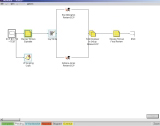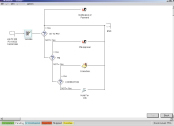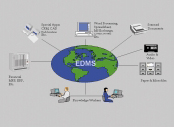
Threat of deregulation, increased energy costs, and substantial growth in the rural communities are forcing Electric Cooperatives to become more efficient and effective in their daily operations.
One of the extensive, daily processes that offers substantial opportunities for efficiency and effectiveness improvement is the management and distribution of mission-critical, documentbased information. Electric Cooperatives spend an extraordinary amount of time chasing the paper trail. Time and money is wasted every day searching for lost or misfiled mission-critical documents, copying documents for distribution, filing and re-filing documents, and routing hard copy documents/folders through business processes. Mission-critical business processes such as Purchase Order Approval, Accounts Payable Reconciliation, Engineering Change Order Processing, and Work Order Processing are slowed due to the slow fulfillment of document requests/requirements.

An Electronic Document Management and Workflow (EDMS) solution provides the cooperatives with the tools necessary to take charge of the paper trail and become more efficient, save money, and service customers on a timelier basis.
It has been proven over and over again that a significant amount of money is wasted every year filing documents, looking for lost or mis-filed documents, and recreating lost or mis-filed documents. Recent studies have shown that manually managing hard copy documents including their handling, storage, maintenance, reproduction, and distribution represents the single largest overhead cost in organizations today. This cost can be eliminated or substantially reduced as a result of implementing an EDMS solution.
Many Cooperatives are currently microfilming some of their documents. This is a very costly way of maintaining documents when you consider the increasing costs associated with operating and maintaining microfilm cameras, readers, and reproduction devices. Whether your maintaining the documents in microfilm form or hard copy form, the direct and indirect costs associated with slow demand fulfillment are substantial.

In most organizations today, a disaster recovery plan is non-existent or, at best, does not reflect the utilization of current technology and technological procedures. Once implemented for support of the many mission-critical, daily business processes, the EDMS technologies provide organizations with a quick, flexible, and inexpensive way of providing backup to those documents representing the “lifeblood” of their operations. Without access to document-based information during times of disaster, the organization is unable to conduct business internally as well as with customers and suppliers.
Using an Electronic Document Management and Workflow automation solution, the cooperative is able to efficiently manage all of the mission-critical documents in electronic format throughout their life cycle, from authoring and/or scan capture through review, approval, distribution, and archiving. The cooperatives are able to eliminate information bottlenecks, and maintain a complete audit trail of their business processes.
There are significant benefits and areas of cost savings associated with automating and improving the document management and distribution processes and procedures within the Co-op, including:
- Improved disaster recovery plan/response.
- Improved responsiveness and communication among the various departments and member companies.
- Reduced cycle times associated with such important business processes as customer work order processing, new hire & grievance processing, engineering change order processing, and accounts payables processing.
- Electronic control and auditing of each step within mission-critical business processes.
- Improved knowledge-worker productivity
- Elimination of vital record deterioration
- Ensure continued compliance with corporate and regulatory agency record retention and auditing requirements
- Absolute document file integrity as a result of automatic version control.
- Decreased on-site storage costs
- Decreased document repository maintenance and reproduction labor, and materials costs
- Immediate access to and utilization of document-based information by field personnel such as construction crews as well as authorized outside organizations such as suppliers of products and services.
An EDMS system is beneficial to every department within a cooperative. Accounting, Engineering and Operations, Purchasing, Right of Way, Human Resources, and Marketing are just a few departments that generate, receive, and distribute many documents throughout the course of a day. All of these documents can be captured electronically; hard copy documents are scanned, native electronic files are archived in their native form, enterprise reports are captured in a print stream, faxed documents are captured at transmission, and mission critical data is accessible from distributed databases. By capturing and managing documents electronically and associating them with existing business system database information, the cooperative has all of their mission-critical data and documents immediately accessible through one application for fast retrieval, control, and distribution throughout the quality chain.
There are several other types of application systems such as GIS, CIS, EA, Staking, and Outage Analysis that cooperatives currently utilize for operating efficiencies. All of those applications also offer cooperatives substantial opportunities for saving time and money and improving customer service, however, without the associated document-based information that is required from various departments, the data from those systems would be incomplete, and in some cases, useless at best. Each of those application systems should be integrated with the EDMS solution to provide ALL of the information when and where it is needed at the users desktop.
An explanation of why each one of the application systems should be integrated with an EDMS solution follows.
Geographic Information Systems – GIS
There are several pieces of documentation that are associated with a GIS system. Deeds, Easements, Plan and Profile Sheets, Staking Sheets, Land Use Agreements, Aerial Photos, Engineering project files, etc, can be associated with information contained in the GIS. A user may need any one or many of these different document types when doing research in the GIS about a specific parcel of land. Most of these documents are found within the EDMS solution. If a user were able to click a point on a map and view all of the documentation associated with that point, it would save a lot of time and data redundancy wouldn’t exist.
Customer Information Systems – CIS
CIS has the largest amount of documentation associated with it. Accounting documents such as Invoices, Packing Slips, and Payment Vouchers, and Purchasing documents such as Purchase Orders, Purchasing Requisitions, RFQs, and RFPs, Work Orders, and Membership Files, are managed by an EDMS solution.
Many cooperatives would like to implement electronic workflow processing in conjunction with their CIS. There are several mission critical processes that could be automated: Purchase Order Requisitions, Work Order Processing, and Accounts Payables Reconciliation. By integrating the EDMS and CIS, the cooperative could streamline their business processes to become more efficient.
There are several benefits to the cooperative in having CIS and EDMS integrated. The integration would save time and money by not having to key enter the information already in the CIS into the EDMS, the users would be able to view the associated documentation on-line, and if the cooperative implemented electronic workflow, approved purchase orders, data corrections, and bill payment could all be uploaded to the CIS automatically to ensure data integrity.
Automated Staking
When laying new lines or setting up new service, there is a lot of documentation that needs to be accessed. Staking sheets, Deeds, Easements, Plan and Profile sheets, Work Orders, and Membership files are a few. Before laying a line, the field engineer must first have a work order, and then he/she must be sure that the cooperative has the legal authority to set up the new service and/or lay the new line. The engineer must also know the entire layout of the Line and any obstacles (man-made or natural) he/she might face when staking. All of these pieces of documentation are managed within the EDMS solution.
Outage Analysis
Every time the power goes out, Cooperatives get a huge influx of calls. Members want their power restored as quickly as possible. There is a lot of documentation associated with finding out where the outage occurred, how it can be fixed, and when it will be fixed. Engineering Drawings, Aerial Photos, Substation Drawings, Remittance Sheets, and Line Drawings are just a few of the types of documentation that are needed to quickly respond to a power outage and fix the problem. For every second the power is out, the cooperative is losing money. In order for a timely resolution of the outage, EDMS and Outage Analysis software need to be integrated to quickly find and share all the necessary information very quickly.
Outage Detection
The biggest advantage of integrating Outage Detection and EDMS is the use of workflow. Once an Outage has been detected and reported, a workflow notification with a description of the problem and all of the associated documentation for a specific area of land can be issued to the responsible individual. Work Orders can then be automatically generated and sent to the responsible engineer or field worker for review and action.
A complete audit trail of the Outage Response process is maintained which allows the cooperative to determine where there are bottlenecks in the process, and allow the cooperative to further streamline that process.
Engineering Analysis
Engineering project files, Drawings, Bills of Material, and Vendor Bid Packets are all important documents to Engineering Analysis. The EDMS solution works to maintain complete data integrity of these documents through version control. All of the data within the EDMS could be shared with the EA to be sure the projects are started and completed on time, and the correct amount of goods and services are ordered.
EDMS is a valuable tool within cooperatives and all other types of organizations. There are documents associated with every department’s functions and almost every type of application program designed to aid the organization with a fundamental part of their business. The more the EDMS solution can be integrated with existing or future applications, the more beneficial and effective all applications become.
EDMS is a “strategic” technology that provides a substantial return-on-investment through decreasing operating costs, improving productivity and quality of products and services, and eliminating the costly “what if ” scenarios associated with disasters.







